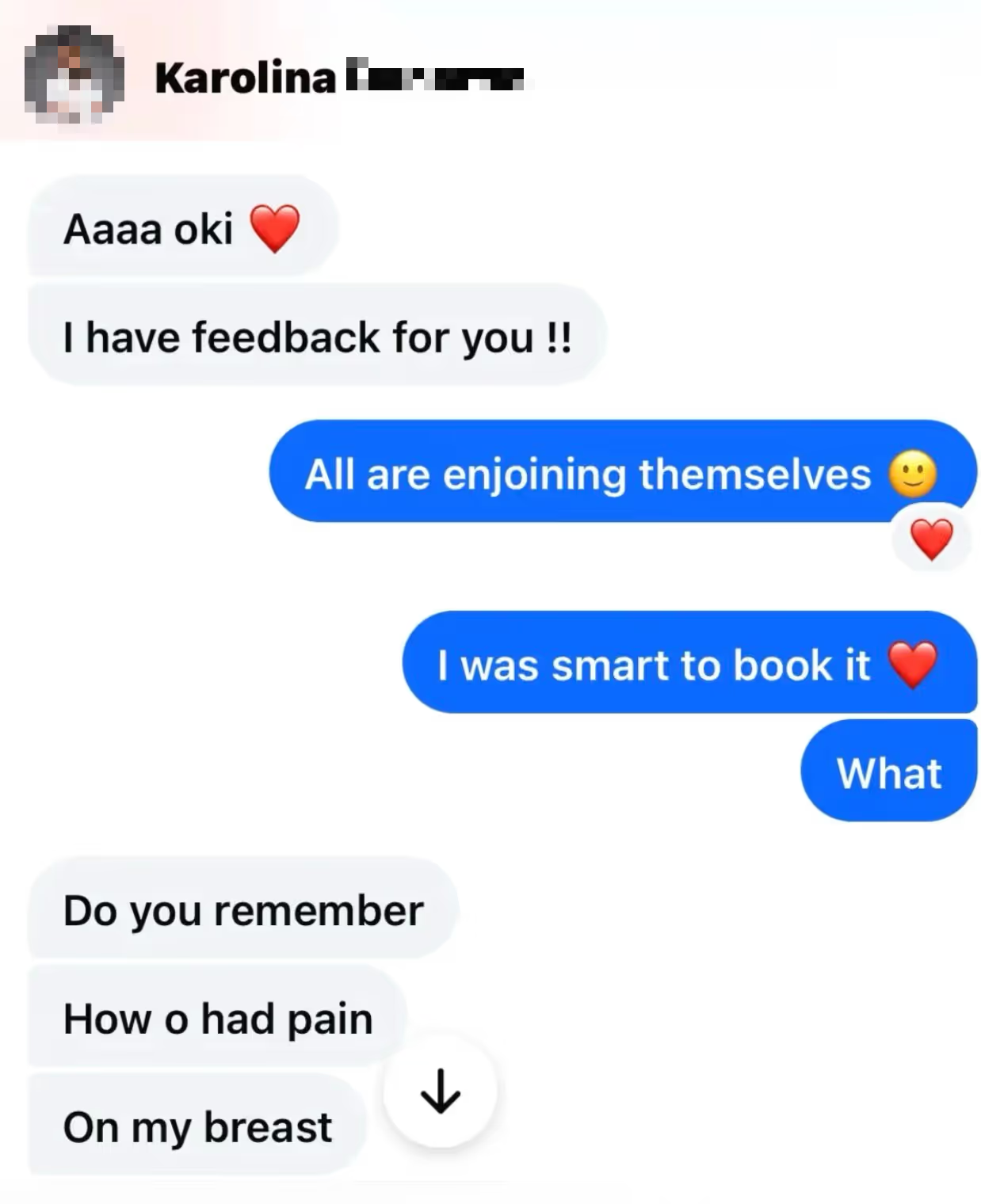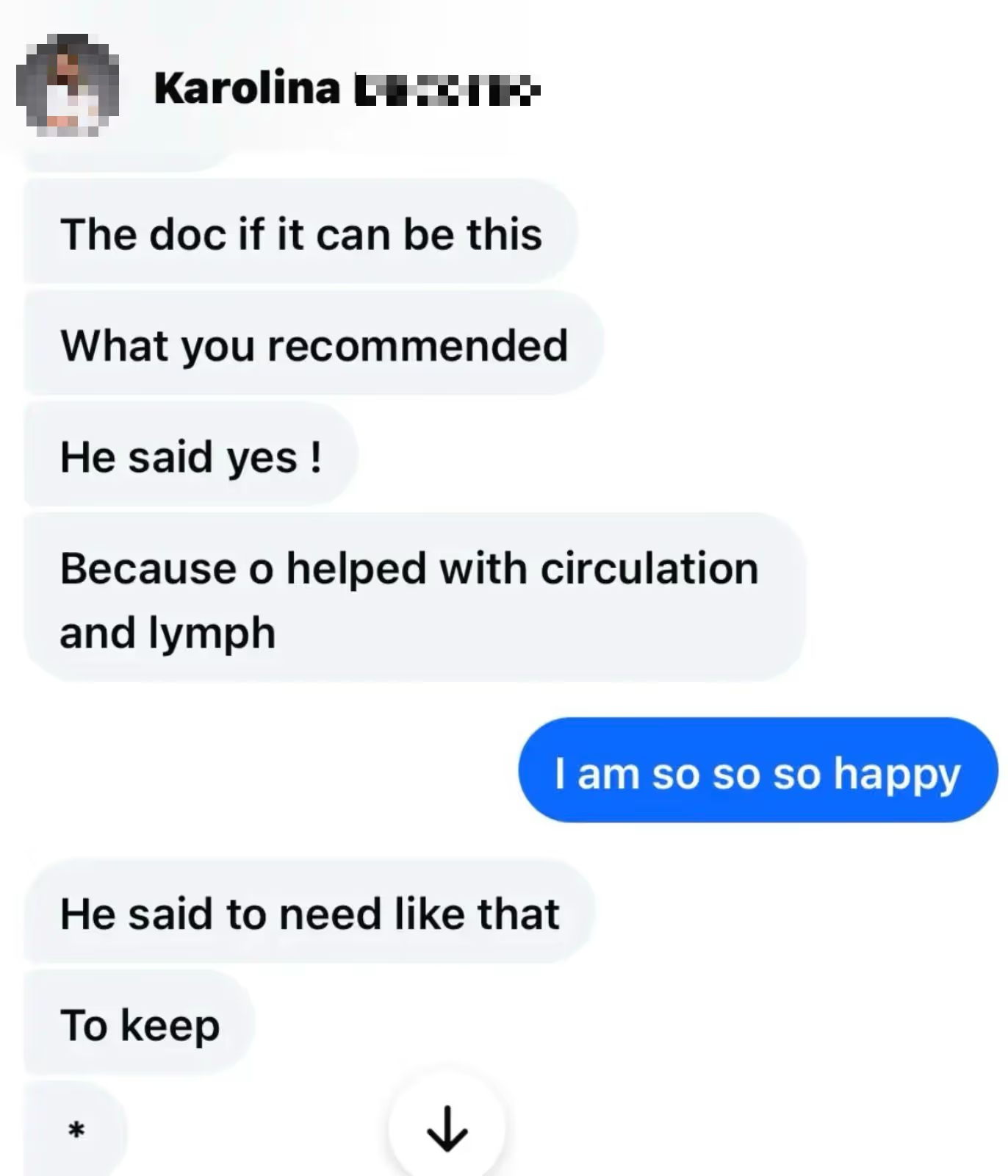The message arrived on a Friday afternoon, cutting through the noise of my daily routine. "I have feedback for you!" Karolina wrote, her words shared with her permission, practically vibrating with excitement through my phone screen.

I paused, remembering the woman who had walked into my yoga studio six months earlier. The worry lines etched around her eyes. The way she held her left arm protectively against her body. The quiet desperation in her voice when she described the constant breast pain that had become her unwelcome companion.
Karolina's fibroadenoma cyst wasn't just a medical diagnosis – it was a daily reminder of vulnerability, a source of sleepless nights and anxious thoughts about what the future might hold.
The Journey from Pain to Possibility
In February, when Karolina first came to me with this pain, her story echoed those of countless women I've worked with over the years. Breast pain from a benign lump had infiltrated every aspect of her life. Simple movements hurt. Sleep became elusive. The emotional weight of carrying this condition felt almost heavier than the physical discomfort.
We started where healing always begins – with gentleness and respect for what her body was communicating. Rather than viewing the fibroadenoma as an enemy to battle, we approached it as information her body was sharing about the need for deeper support.
Our work together involved three integrated elements: gentle breast massage to encourage lymphatic flow, specific arm, armpit and chest opening movements to create a free movment of the lymph, and targeted Hormone Yoga Therapy techniques designed to address the hormonal environment that influences breast tissue health.
Within just a few practices, Karolina's pain vanished completely. The relief was immediate and profound, but she continued with the daily massage and gentle yoga sequence, trusting the process her body had initiated.
When Ancient Wisdom Meets Modern Medicine
Six months later, Karolina's routine medical check-up delivered news that surprised us both.
"It started decreasing in size," she messaged me with barely contained excitement. "The biggest one which was growing... All the time…Is smaller 5 mm. I asked the doc if it can be this what you recommended. He said yes! Because it helped with circulation and lymph."


Her doctor's acknowledgment represents a significant shift in medical thinking. For years, women have been told that fibroadenomas are simply something to "watch and wait" with, as if our bodies were powerless to influence these benign growths.
The science tells us otherwise.
What Research Reveals About Natural Healing
The medical literature contains remarkable insights that challenge our assumptions about the body's capacity for self-healing. Research published in leading genetics journals reveals that 59% of fibroadenomas contain specific genetic mutations affecting estrogen signaling pathways, making them exquisitely responsive to hormonal changes.
More encouraging still, studies document that 16-59% of fibroadenomas undergo spontaneous regression over five years, with the probability of natural resolution reaching approximately 50% after this timeframe. This isn't wishful thinking or alternative medicine speculation – this is documented medical reality published in peer-reviewed journals.
Research on controlled interventions has demonstrated that approaches targeting estrogen pathways can achieve 31.88% complete regression of fibroadenomas compared to 7.69% in controls, validating that addressing underlying hormonal factors can create measurable improvements.
Understanding the Stress-Hormone-Tissue Connection
What makes Karolina's transformation particularly compelling is how it illuminates the intricate connections between stress, hormones, and breast tissue health. When we worked together, we weren't just addressing her physical symptoms – we were creating an environment where her body's natural healing mechanisms could function optimally.
Research published in Breast Cancer Research reveals that chronic stress creates a cascade of hormonal changes directly affecting breast tissue. Prolonged cortisol exposure suppresses natural cellular repair mechanisms while simultaneously increasing local estrogen production within breast tissue itself.
This creates the exact environmental conditions where fibroadenomas thrive – elevated local estrogen combined with compromised cellular repair systems.
The breathing techniques and gentle movements we practiced work through multiple pathways to reverse these conditions. They activate the parasympathetic nervous system, reducing cortisol production. They enhance circulation and lymphatic drainage, improving the tissue microenvironment. They support hormonal balance through mechanisms that research has extensively documented.
The Lymphatic System: Your Body's Hidden Healing Network
Karolina's doctor specifically mentioned circulation and lymph when explaining her improvement, and his observation reflects sophisticated understanding of breast tissue physiology.
The breast contains intricate lymphatic networks that play crucial roles in tissue health and cellular repair. When this system functions optimally, it removes metabolic waste, supports immune function, and maintains the healthy tissue environment necessary for natural healing processes.
The gentle movements and conscious breathing we practiced create optimal conditions for lymphatic flow through coordinated muscle contractions and pressure changes. This isn't theoretical – clinical studies using advanced imaging techniques can measure increased lymphatic circulation following specific movement patterns.
Reclaiming Agency Over Your Health
Beyond the measurable physical changes, Karolina's journey represents something equally important: the reclaiming of agency over her own health. When she first came to me, she felt like a passive recipient of medical circumstances. Through our work together, she discovered her body's remarkable capacity for self-healing when provided with appropriate support.
This psychological transformation matters profoundly. Research demonstrates that stress reduction interventions create measurable physiological changes lasting up to 12 months. When we move from fear and helplessness into empowerment and active participation, we literally change our body's biochemical environment in ways that support healing.
The Convergence of Multiple Healing Systems
Karolina's 5mm reduction represents the convergence of multiple healing mechanisms working synergistically:
Her consistent practice created hormonal rebalancing that shifted the estrogen-progesterone environment away from conditions favoring fibroadenoma growth. The stress reduction addressed cortisol-mediated pathways that had been promoting local estrogen production. Enhanced circulation and lymphatic drainage improved the tissue microenvironment around the fibroadenoma. Improved cellular repair mechanisms resulted from reduced oxidative stress and enhanced parasympathetic function.
None of these mechanisms worked in isolation. They functioned as an integrated system, supporting her body's natural capacity for healing and regeneration.
What This Means for Your Journey
Individual responses vary, and I would never suggest that every woman with a fibroadenoma will experience identical results. Bodies are wonderfully complex, and healing unfolds differently for each person.
However, Karolina's story illuminates something profound about the relationship between mind, body, and healing. When we approach health challenges not as battles to fight but as opportunities to support our body's innate wisdom, remarkable transformations become possible.
Whether you're dealing with breast health concerns, hormonal transitions, or other wellness challenges, the principles remain consistent: your body possesses extraordinary intelligence and healing capacity when provided with appropriate conditions and support.
Moving Forward with Wisdom and Wonder
Karolina's final message to me was beautifully simple: "I don't know how I should thank you."

But she had already provided the greatest gift – proof that when ancient wisdom meets modern understanding, when we honor both scientific knowledge and body wisdom, when her consistent practice rises above fear and inertia, healing emerges in ways that continue to surprise and inspire.
Her doctor's acknowledgment that the yoga practice "most probably" contributed to the improvement represents medicine at its most honest and hopeful. As research continues validating these connections, we move toward healthcare that honors both rigorous science and the body's remarkable capacity for self-healing.
The question isn't whether these mechanisms work – it's whether we're ready to embrace a more complete understanding of what healing truly means.
Ready to explore how gentle, evidence-based practices might support your own healing journey? Join the waitlist for my next Hormone Yoga Therapy group program to learn these transformative techniques in a supportive community setting. Registration opens on Friday.
Free Email Course to Better Understand Your Hormones
Get clear, practical information directly to your email, to help you manage hormonal changes.
In just few minutes a day, you'll learn:
The real reasons behind hot flashes and mood swings
2-minute breathing techniques you can use anywhere
Simple yoga poses that balance your hormones
Quick fixes for sudden symptoms during meetings
Daily practices that create lasting change
Each email brings you closer to understanding and working with your body's natural rhythms.






